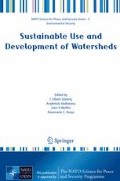Abstract
The Analytic hierarchy process (AHP) is used to build up and solve participatory decision making model and improve management of selected regional hydro system in northern Serbia. Recently, serious conflicts in the case study area are evidenced among governmental bodies, local authorities in municipalities, responsible water management companies, ecologists, public bodies etc. The reason for conflicts is lack of funding, improper legislation or absence of precise water policies, low efficiency in water taxation and obstruction of societal and political representatives to participate in management.
The decision-making model (hierarchy) is established with four levels and 13 decision elements. The overall goal is set at the top of hierarchy as a ‘benefit for all’. Second level consists of three criteria (economic, social, and ecological) and five more decision elements are defined at the third level as primary system purposes (irrigation, drainage, used waters, industrial water supply, and other purposes). At the bottom of the hierarchy, four management strategies are posted as the decision alternatives, defined by authorized water management company. Model is established by consensus and then assessed by five key interest groups gathering in total 23 individual participants. At the final stage, the best strategy is identified by aggregating the alternatives’ weights obtained in groups, assuming also that groups may have different importance in deriving the final solution.
Successful structuring and solving the participative decision-making model, based on the AHP methodology, indicated promising and scientifically sound approach in improving the decision making practices on regional scales. Results of this practically performed experiment recommend this modeling and solving concept for further use, at least in situations similar to this Serbian case study example.
Access this chapter
Tax calculation will be finalised at checkout
Purchases are for personal use only
Preview
Unable to display preview. Download preview PDF.
References
EC2000, 2000. Expert Choice Software Package for IBM PC, Users Manual, Pittsburg, PA.
Forman E, Peniwati K., 1998. Aggregating individual judgments and priorities with the ana-lytic hierarchy process, European Journal of Operational Research 108, 165-169.
Saaty T., 1980. Analytic Hierarchy Process, McGraw-Hill, New York.
Srdjevic B., Petkovic S., 2004. Study of Irrigation, Drainage, and Flood Control Policies in Serbia, Background paper for World Bank, Belgrade.
Srdjevic Z., Srdjevic B., Tomin M., 2005a. Participatory Decision Making Model for Regional Hydro-System Nadela in Serbia: Case Study, In Abstract Volume of the 15th Stockholm Water Symposium (World Water Week), p. 172, August 21-27, 2005, Stockholm, Sweden.
Srdjevic B., Srdjevic Z., Tomin M., 2005b. Application of the analytic hierarchy proc-ess in evaluating usage of the Nadela regional hydrosystem, In: Proc. ‘Meliorations in Sustainable Agriculture’, Faculty of Agriculture, Novi Sad, Serbia and Montenegro, pp. 183-192 (in Serbian).
Srdjevic B., 2007. Linking Analytic Hierarchy Process and Social Choice Methods to Support Group Decision-Making in Water Management, Decision Support Systems 42, 2261-2273.
Srdjevic Z., Kolarov V., Srdjevic B., 2007. Finding the Best Location for Pumping Stations in the Galovica Drainage Area of Serbia: The AHP Approach for Sustainable Development, Business Strategy and Environment 16:7, 502-511.
Author information
Authors and Affiliations
Editor information
Editors and Affiliations
Rights and permissions
Copyright information
© 2008 Springer Science + Business Media B. V
About this paper
Cite this paper
Srdjevic, B., Srdjevic, Z. (2008). Multilevel Participatory Model for Decision Making on Regional Hydro-System Basis: Serbian Case Study. In: Gönenç, İ.E., Vadineanu, A., Wolflin, J.P., Russo, R.C. (eds) Sustainable Use and Development of Watersheds. NATO Science for Peace and Security Series. Springer, Dordrecht. https://doi.org/10.1007/978-1-4020-8558-1_12
Download citation
DOI: https://doi.org/10.1007/978-1-4020-8558-1_12
Publisher Name: Springer, Dordrecht
Print ISBN: 978-1-4020-8557-4
Online ISBN: 978-1-4020-8558-1
eBook Packages: Earth and Environmental ScienceEarth and Environmental Science (R0)

